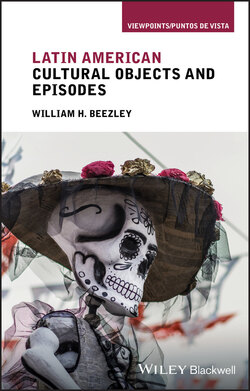Latin American Cultural Objects and Episodes

Реклама. ООО «ЛитРес», ИНН: 7719571260.
Оглавление
William H. Beezley. Latin American Cultural Objects and Episodes
Table of Contents
Guide
Pages
Latin American Cultural Objects and Episodes
Series Editor’s Preface
Call…cry…shout…yell “Ooo‐wa‐ooo‐aaooaaooaa‐ooo!” or “Taaar‐maan‐ganiii”
Note
Introduction Res humanitatis, A Montage
Notes
Acknowledgments
1 Bowler Hats
Additional Resources. Readings
Notes
2 Magic Beans
Additional Resources. Readings
Video
Notes
3 Red Flags
Additional Resources. Readings
Videos
Notes
4 Roasted Chicken
Additional Resources. Reading
Video
Notes
5 Eye Patches and Telenovelas
Telenovelas Redux
Additional Resources. Reading
Notes
6 Ugh! Soup!
Additional Resources. Reading
Notes
7 Holy Wurlitzer
Additional Resources. Readings
Recorded Music
Notes
8 Mapuche Flag and Rap
Additional Resources. Discography
Notes
9 Eye Patch Laughs and Bubble Gum Wraps
Additional Resources. Reading
Video
Notes
10 Ski Masks
Additional Resources. Reading
Notes
10 Coda Ski Masks and Soccer
Notes
Re‐Call and Conclusion
Conclusions
Notes
Bibliography. Archives
Online Sources
Books and Articles
Unpublished Materials
Correspondence and Interviews
Index
WILEY END USER LICENSE AGREEMENT
Отрывок из книги
Viewpoints/Puntos de Vista Themes and Interpretations in Latin American History
.....
The company made different styles, but two models in particular became associated with Borsalino: the Panama, made from paja toquilla fiber (Carludovica palmata), found particularly in Montecristi, Ecuador, processed with a technique called “the fuma” to produce its unique ivory color, and the derby, which was and still is made of felt and a mixture of different furs including rabbit, treated until it produces a soft fabric. The latter became extremely popular and was exported worldwide under the patented name “Borsalino.” Its unmistakable shape has reached iconic status over the years. The hats made the company a success. From the beginning, Giuseppe had respect for his workers and their needs, so he developed for them both health insurance and a pension fund. At his death in 1900, the company had nearly a thousand workers, boasted an annual production of one million hats, and exported 60 percent of its production overseas. Teresio Borsalino succeeded his father, headed the company for 39 years, and added to its success. By 1913, it employed more than 2,500 workers with an annual production of more than two million hats sold throughout the world. Teresio Borsalino’s nephew, Teresio Usuelli, the last heir of the Borsalino family, took over as chairman and served until 1979, when he left the company in the hands of Vittorio Vaccarino. In 1986 the company moved from its factory originally located in the center of Alessandria to a new, more efficient and modern site in the town’s suburbs. Initially, the old factory housed a hat museum until a few years ago, when the museum moved and the site became Eastern Piedmont University.23 Roberto Gallo now holds the title of CEO and president of the company and has expanded it to include Asia and the U.S. (with Borsalino America). There are now more than 15 flagship stores in Italy, France, and China. The Borsalino name has continued to figure prominently in fashion history. Today Borsalino’s hats extend beyond the classic felt derby and the famous straw “Panama‐Montecristi” to new styles targeting the young hat wearer. All the world’s fashionable stores, such as Harrods in London and Saks on Fifth Avenue in New York, stock Borsalino’s famous hats. The company now has men’s, women’s, and children’s ready‐to‐wear collections as well as accessories from perfumes to eyewear. With an annual turnover of almost 30 million Euros, Borsalino remains the leader in Italian hat manufacturing. Over the years the Borsalino family has not only made an impact on the history of fashion with their famous hats, but also they have influenced the history of their town. They are renowned for the charitable work they have done since the company started. They have financed public works, from the aqueduct to the orphanage to the old sanatorium, for the city of Alessandria.24
Adopting these derbies, the Cholitas joined other famous groups and individuals wearing the iconic Borsalino hat. The Pope had one, as did other church prelates, and they were worn by the Royal Canadian Mounted police, Sephardic Jews, and New Yorker Emma Stebbins, who sculpted the Angel of the Waters at the Bethesda Fountain in Central Park.25 In the 1920s movie stars adopted the hat. In Hollywood, Charlie Chaplin’s Tramp character, Greta Garbo, and Lou Costello, along with Stan Laurel and Oliver Hardy, were well known for their bowler hats, which they used as accessories, twisting the rim, doffing them, and adjusting the angle on their heads to denote mood. A mainstay expression of anger or frustration, especially in silent films, had an actor punch out the crown of his derby; part of the joke was that the actor could not break the hardened shellac hat unless it previously had been weakened. Later Humphrey Bogart wore a Borsalino, notably in Casablanca (1942), as did the famous World War II correspondent Ernie Pyle.
.....